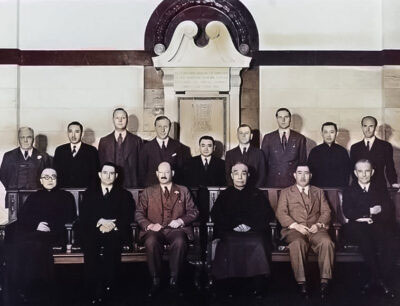
This case study stems from my initial interest in the role of local elites in the management and transformation of Shanghai. The possibility today to harvest data from the press — Shanghai harbored the largest number of periodicals and newspapers in China —as well as print documents (annual reports) and archives (SMC minutes) opens the way to re-examining the issue of power in Shanghai at the level of the whole city. There is a very rich historiography about Shanghai, which actually provides an extremely dense network of scholarly works — monographs, academic papers — and a reservoir of accurate information on a wide range of actors in the city. The multiplication of monographs has focused on specific groups (bourgeoisie, workers, artists, British, Japanese, etc.), organizations (native-place associations, students associations, universities, Shanghai Municipal Council), topics (security, health, city planning, architecture, industry, cinema etc.), and even areas (French Concession, International Settlement, Chinese municipality, etc.). This is a blessing as it offers many venues into the social and political fabric of the city.
For most of its history between the forced opening to Western trade in 1842 and the collapse of the Nationalist regime in 1949, Shanghai was one city under three separate and autonomous jurisdictions, legal systems, and administrations. It remained solidly part of Chinese territory — Shanghai as a « free city » only existed in the mind of some illusory Westerners —but the establishment of foreign settlements and their centrality for a century created a polymorphous political arena. What in itself is a challenge in any urban settlement — how to handle a fast-growing population coming from many parts of China and the world, how to manage basic urban services, how to support and promote economic development, how to balance public and individual interests, etc. — became a delicate exercise prone to derailment in a configuration where power was divided spatially, socially, and ethnically. Competing groups of Chinese and foreigners challenged as well sought to take advantage of the soft boundaries that permeated the city. Protests about taxation, dredging the canals or moving a cemetery could easily slip into rioting and violence. In everyday management or in periods of crisis, the elites of Shanghai played a defining role. But which elites?
The notion of « power elite » is somehow anachronistic. It is a concept developed in the 1950s about the existence of a network of interwoven interest between elite members of the military, business, and politics. I use it here to answer three related questions: Who governed? Who ruled? Who owned Shanghai? The first two terms (govern/rule) refer to a fascinating debate that remains particularly relevant in the case of late Qing and Republican Shanghai. There were three administrations, there were powerful social organizations, especially among the Chinese, and there were dense networks at all levels of society. All these elements combine to create a configuration where there was no clear cut power structure in the city, which actually forced the leaders in the various social structures to find ways to come to terms with each other and to compromise to maintain social order, to shape city development, and to preserve/promote their respective interests. The historian can observe the flux of interactions both in day-to-day actions and in times of tension or crisis in a variety of sources. In this case study, the press will figure prominently since elite members of society interacted often as public figures in public events. One can also trace their interactions in more private settings, but still in a formal or informal capacity in public institutions that left records (reports, minutes).
Methodologically, beyond the general call of data mining, a major challenge will be first to identify all the actors that had a hand in driving the city. Individuals changed over time, for obvious biological reasons, but also because of a constant reshuffling of actors. Their nature, social background, education, and professions became more diverse. Although major figures are easy to identify, we should not limit ourselves to a pre-scripted list. On the opposite, it will be essential to reveal a broader spectrum of individuals, even if they played an occasional or momentary role. This leads to the second major challenge: identifying and characterizing the wide range of events that revealed elites in action and may shed light on the processes behind rising to the status of the social elite. Rather than relying solely on landmark events — which will be used as well — my approach is to explore events in the making, « budding events » that may have blown into significant or even historical events or just stopped short of any development. Last, this is about identifying the connections and unveiling the networks that actually shaped and framed events et actors, not in the loose sense that dominates in past studies, but through rigorous methods and concepts. Whether, in the end, the existence of a « power elite » in Shanghai can be ascertained remains an open question at this stage, but pursuing this study will contribute to lifting the veil on social stratification, social transformation, and power in modern Shanghai.